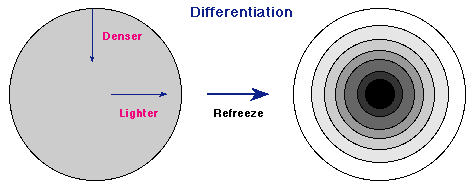 |
| The process of geological differentiation |
The Earth did not have the interior structure described in the preceding section when it was formed. The geological process by which the Earth came to have its present interior structure is called differentiation, and is illustrated in the following figure.
 |
| The process of geological differentiation |
Within about 1 billion years of its formation the Earth was melted by heat arising from a combination of sources:
As we shall see, this has enormous implications for the subsequent geological history of the Earth because it produces conditions favorable for plate tectonics. One of the crucial questions that we will have of all solid bodies in the Solar System is whether they have ever been differentiated.